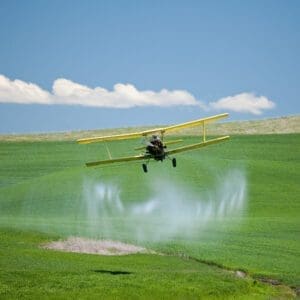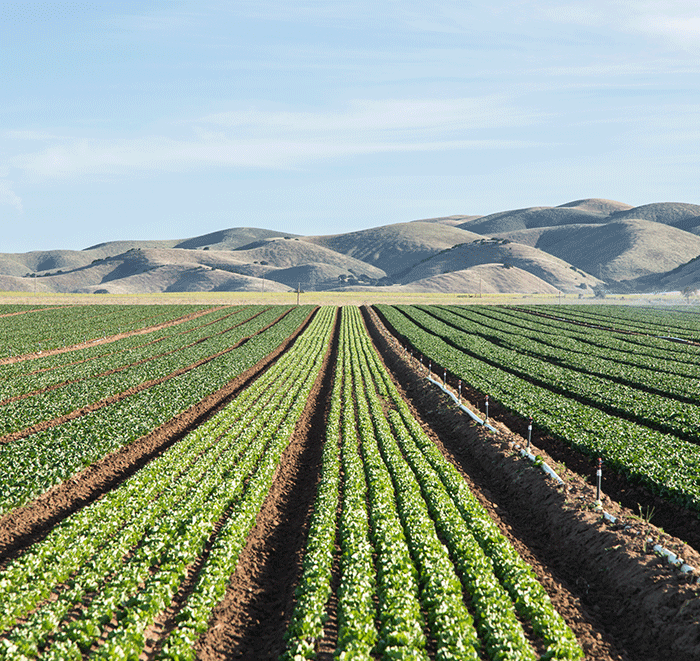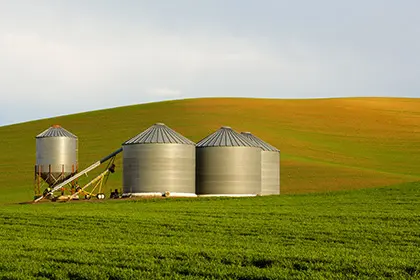Beating Weeds in Wheat: Deliver a One-Two Punch in the Palouse
In the rich and well-drained loess hills of the Palouse in eastern Washington and western Idaho, the yields of soft white winter wheat can easily achieve 120 bushels per acre and even climb to 150 bushels per acre. Though the region boasts some of the world’s most productive soils and a favorable growing climate, the slope of these fertile hillsides presents production challenges unlike any other.
“Throughout most of the Palouse, we are blessed with a gorgeous silty loam soil that is pretty high in organic matter,” says Gracie Kincaid, agronomist with Wilbur-Ellis Agribusiness. “It is super cooperative, super productive soil if we can keep it on our hills.”

Productive, yet challenging.
Throughout the area, slopes range from zero up to 60 percent, which places fields in the region in the ‘highly erodible’ category. To reduce the potential for water erosion, nearly all crop production activity is done on the contour. Many wheat growers employ reduced or no-till practices, and weed control is achieved with herbicides.
However, in the Palouse like many other areas, reliance on herbicides for weed control has caused herbicide resistance, particularly in the more arid regions where the average rainfall is 10 inches per year. In these areas, many farmers have turned to chem fallow as an alternative to tillage for weed control in traditional summer fallow when no crop is being grown.
“Chem fallow has historically been the weed control with four treatments of glyphosate throughout the growing season,” says Kincaid. “Glyphosate is a great tool, because it is a sustainability-oriented practice, giving us the freedom to reduce tillage which is not only costly but creates the potential for wind erosion.
“We don’t want to lose glyphosate from our toolbox, so we have to be more creative and intentional with our herbicide programs,” she stresses.
To extend the longevity of this technology, Kincaid recommends rotating alternative modes of action for weed control in fallow acres. She often recommends products with paraquat as the active ingredient, particularly in fields with hard-to-control weeds such as herbicide-resistant Russian thistle. It is an effective burndown and alternative to glyphosate.
Feed the crop, control the weeds.
Kincaid also reminds growers that fertility is an important aspect of a weed control team for the wheat crop.
“Crop competition is our best herbicide. The most effective way to control weeds is by giving the wheat crop the best chance to grow and flourish that we can,” she explains. “A good fertility program also helps us reach top yields.”
To that end, she encourages several applications of fertilizer, with the bulk of the needed nitrogen, sulfur and phosphorus along with zinc, boron and copper applied before or at planting in the fall, helping encourage seedlings, establish the crop and develop a sound root system to take it through winter dormancy.
As temperatures rise in early April and the crop begins to break dormancy, an early top-dress application of nitrogen kickstarts the tiny wheat plants to help them quickly outgrow emerging weeds and gear up to create as much grain as possible.
Delivering the one-two punch.
For effective weed control and optimum yields, the one-two punch for the wheat crop comes in late April and May when it is time to control broadleaf and grassy weeds such as downy brome, jointed goatgrass, cereal rye and Italian ryegrass that steal nutrients and moisture from the crop and tally up weed seed dockage if left uncontrolled into harvest.
Kincaid recommends applying a broad-spectrum Group 1 or Group 2 herbicide that effectively controls grassy and broadleaf weeds. She also stresses the importance of choosing the right tank-mix partner, such as a surfactant, to ensure there is optimal absorption of the herbicide by the grassy weeds.
“Always read the product label for approved tank-mix partners. Using the right surfactant will help ensure those grassy weeds absorb the herbicide for good control and return on your herbicide investment,” she explains. “This is also a good tactic to help prevent herbicide resistance because optimal absorption helps ensure we get thorough control of the problem weeds.”
This weed-control pass is also a great time to make a foliar application of nitrogen and other needed nutrients to give the wheat a competitive boost. Products such as NDemand® 30L, a 30% nitrogen fertilizer applied at 1-2 gal./ac. is a good choice for an average yield boost of 4.1 bu./ac. in wheat.

Rounding out the nutrition for plant health, optimum yields.
Soil pH is another challenge of growing wheat in the Palouse. For growing wheat, the pH should be above 5.5. Years of crop production have taken the pH below 5.5 causing soil nutrient availability to drop rapidly. At pH 5.0, only half of the nitrogen and potassium and only one-third of the phosphorous is available to wheat. With lowered soil pH, micronutrients such as zinc, copper and boron also become less available to crops.
To overcome this challenge, a foliar application at the flag leaf stage is the opportunity to apply more nutrients: nitrogen, zinc, copper and boron, and fungicide for protection against rust.
“When we have good moisture, we not only have the potential for top wheat yields, but we also often face rust,” Kincaid says. “With an application at the five leaf or flag leaf stage, we can apply a fungicide plus nitrogen and the micronutrients on the plant surface, where they’re readily absorbed and not tied up in the soil. The micronutrients not only boost yield, but help the plants better tolerate disease pressure.”
For more information on boosting wheat yields and controlling problem weeds, contact your local Wilbur-Ellis location and a crop production expert near you.

